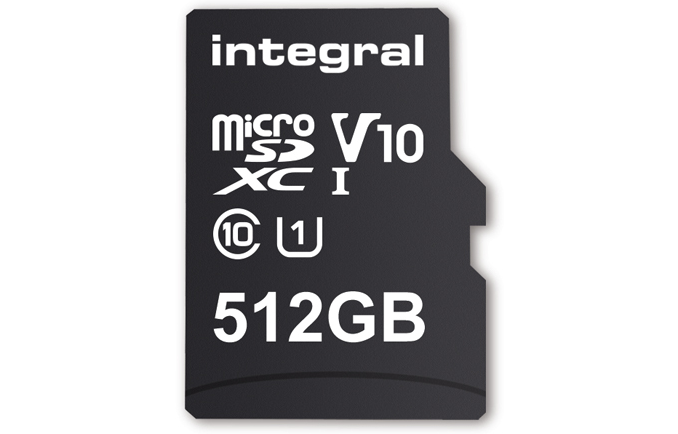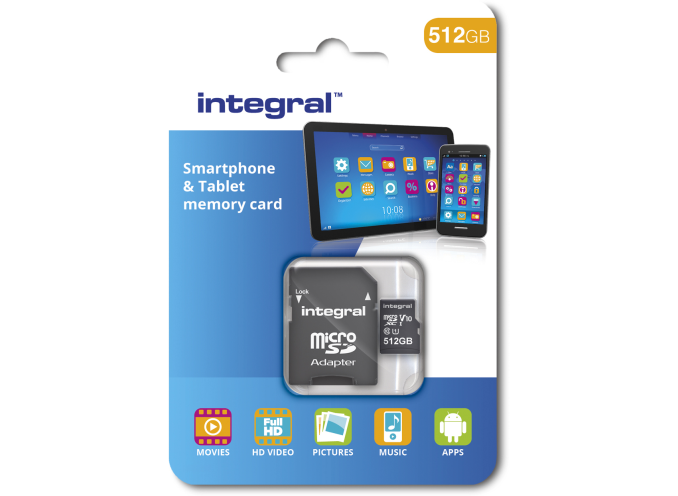Integral Launches 512 GB microSDXC Card: UHC-I, U1, Class 10
by Anton Shilov on January 25, 2018 1:30 PM EST
Integral Memory has released the industry’s highest-capacity microSDXC memory card that one can buy today. Integral’s new 512 GB microSDXC V10, UHS-I U1 card can store half of a terabyte of data, but its performance is not very high, meeting only the V10 specification for sequential write speed, limiting the recording of 4K video.
Integral’s 512 GB microSDXC card belongs to the company’s Class 10 UHS-I U1 lineup that already includes various capacities from 8 GB to 256 GB. These cards are aimed at Google Android-based smartphones, as well as tablets, and are designed primarily to store videos and images. The 512 GB microSDXC card uses the UHS-I bus and delivers up to 80 MB/s data transfer rate. The card also carries the Class 10 and UHS Speed Class U1 labels which guarantee that it supports at least 10 MB/s minimum sequential writing speed, which is enough for taking pictures and FHD videos. Meanwhile the card does not support any Application Performance Classes and therefore might not be suitable for huge mobile games or VR applications.
A number of manufacturers demonstrated microSD cards featuring 512 GB and even 1 TB capacities (some are even listed), but none of them has started commercial shipments of such products. The highest-capacity microSD card available today is the SanDisk Ultra Plus 400 GB that can be used to store applications.
| Integral 512 GB microSD Card at a Glance | |||
| General Specifications | |||
| Usable Capacity | ~512 GB | ||
| Read Speed | up to 80 MB/s | ||
| Write Speed | |||
| Minimum Sequential Write Speed | 10 MB/s | ||
| Operating Temperatures | 32ºF to 140ºF (0ºC to 60C) | ||
| Interface | UHS-I | ||
| Availability | February 2018 | ||
| SDA Labels | UHS-I, Class 10, U1 | ||
Integral plans to start selling its 512 GB microSDXC V10, UHS-I U1 card sometimes in February, but says nothing about its price. Typically Integral’s microSD cards for smartphones are shipped with a USB OTG (On-The-Go) microSDHC/XC card reader featuring dual USB connectors, but it looks like in case of the 512 GB microSDXC card the company will only supply a microSD-to-SD adapter.
For xkcd fans, this means that with microSD cards we can now reach 12.8 PB per gallon.
Related Reading
- Western Digital Launches SanDisk Ultra microSD Card with 400 GB Capacity
- SanDisk Launches Extreme PRO SD Cards: Up to 512GB
- ADATA Demonstrates 256 GB microSDXC Card
- Sony Announces SF-G UHS-II SD Cards: Up to Nearly 300 MB/s Read/Write Performance
- ADATA Demos A2-class microSD Card with 4K/2K IOPS Minimum, Mulls Late 2017 Launch
- ADATA Launches Premier ONE UHS-II SD Cards: 3D MLC, Up to 290 MB/s, V90 Labels
Source: Integral











22 Comments
View All Comments
Pork@III - Thursday, January 25, 2018 - link
"For xkcd fans, this means that with microSD cards we can now reach 12.8 PB per gallon."Gallon beer or gallon fuel? :D
boeush - Thursday, January 25, 2018 - link
Gallon of BenjaminsWinterCharm - Thursday, January 25, 2018 - link
It's per gallon of beer (data over volume, not storage over fuel consumed)shabby - Thursday, January 25, 2018 - link
Who?Lord of the Bored - Friday, January 26, 2018 - link
Batman.willis936 - Tuesday, January 30, 2018 - link
Randal Monroe. You must be new here.https://what-if.xkcd.com/31/
Pinn - Friday, January 26, 2018 - link
Are UFS cards dead?stay.noided - Friday, January 26, 2018 - link
"These cards are aimed at Google Android-based smartphones"The (shrinking) handful of high-end handsets that have an SD card slot.
Thanks Apple, by the way, for starting that dumpster fire.
shabby - Friday, January 26, 2018 - link
The speed of sdcards is painfully slow compared to the ssd like speeds of internal memory, it's just that we need more than the 32/64gb sizes typically found in non apple phones.Tams80 - Friday, January 26, 2018 - link
Oh boy, do we have to have this discussion again? I thought this had been settled on here when the readership thoroughly rinsed AnandTech for a certain article.Look, the long and short of it is that while slow, the speed is good enough for many people.